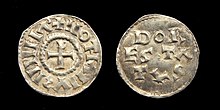Dorestad
Dorestad (Dorestat, Duristat) was an early medieval emporium, located in the present-day province of Utrecht in the Netherlands, close to the modern-day town of Wijk bij Duurstede.
[1] Over time, many coins have been discovered in the Dorestad area, supporting the idea of rapid growth and control of the harbour as well as the presence of a mint.
[4] As a result, the Franks slowly lost interest in the town and granted the Church of Utrecht responsibility over a sizeable portion of Dorestad.
[1] By the 830s, under the control of Louis the Pious, the expansion of the harbour had halted altogether, but coins continued to be minted for some time.
[citation needed] As a result, Louis the Pious quickly took back Dorestad and exiled his son to Italy.
[1] While Frankish defence was organized, that did not stop the Danes from capturing Dorestad and a large portion of the Frisian Coast in 850.
[1] According to Forte, Oram, and Pedersen, Dorestad, "...despite the slaughter and sack of the 830s seems quickly to have recovered its prosperity after each episode, and its disappearance in the 860s was a consequence of a shift in the course of the river channel along which its trade flowed rather than a result of Viking raids.
Along one route, Dorestad was connected to the Dutch mudflats and Frisian area in the north of the Netherlands via the Kromme Rijn, the Utrechtse Vecht and the Almere Lake.
Charlemagne's attempt to subject the Saxons east of the Elbe by annexing Nordalbingia led to a feud between the factions of Halfdan and Godfred, two supposed sons of Sigfred.
[citation needed] The eldest son of Louis the Pious, Lothair, made use of the services provided by the Danish clan of the former King Harald Klak, who fled to Francia in 814.
In 826 Harald and his clan were baptised in Mainz, after which he received the East-Frisian county Rüstringen, of which the Gaus Östringen, Wangerland, Harlingerland and a part of Norderland may have consisted.
[citation needed] When Lothair got in a feud with his father Louis over his reassignment of the Empire in 829, he gave orders to Harald the Younger, the nephew of Harald Klak, to make Frisia an unviable asset to King Louis by means of making crucial trade routes unsafe to travel and burning Dorestad to the ground.
This would stagnate the transport of goods to the main areas of Francia, therefore forcing Louis to admit to the demands of Lothair.
With the Treaty of Verdun in 843 the feud between the brothers ended and the Empire got divided once again, and Lothair got to rule over all of Frisia north of the Schelde, which became part of Middle Francia.
[citation needed] After the death of Louis the Pious in 840 a new feud developed between his three sons, but over in Frisia, Lothair had a strong position because of the Danish Warlords that were situated in Rüstringen, Dorestad and Walcheren.
Frisia stayed related to the Heathen Baltic Sea culture, and felt threatened and repressed by the centralized way of leadership and the Christian beliefs.
It was discovered Dorestad was situated one mile north of Wijk bij Duurstede and was approximately 3 square kilometres in size.
[citation needed] While the "upper town" was never excavated, the soil of the site has been examined and tested positive for phosphates that confirm its existence.
Some Carolingian artefacts have been found over the years in the trading centre; however, the majority of items discovered date back to the Roman fortress that was established prior to the 7th Century.
[1] The conception of the Upper and Lower township is supported not only by archaeological evidence, but a poem was discovered by the English clergyman Alcuin, written at the end of the 8th century, referring to the town as Dorstada which is a pluralization of the name.


